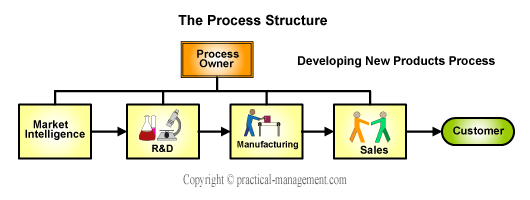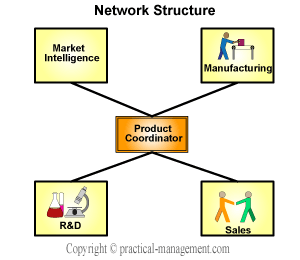Process Vs Network Structure
The process and network structure are forms of horizontal structures, this article explains the two models and their key differences.
The Process Structure
The process structure is a horizontal approach where instead of organizing along the product or function, the organization is structured along the key processes. Typically, a process refers to a set of related tasks and activities that work together in a predetermined sequence to transform inputs into user consumable outputs. The main challenge is to identify the core business processes which produce product or service that is directly consumed by the customers.

A divisional structure can be reorganized horizontally by identifying the dependencies between different divisions or sub-divisions. Similarly, a matrix can be sliced horizontally along the product management and inter-connected based on interdependencies, such decomposition and realignment results in identification of core business processes. Once the core processes are identified, multi-skilled teams around the sub-processes are created and each team is lead by a process owner. The process owners have the complete responsibility for each core process.
Strengths of process structure
- Strong Customer Orientation: The entire structure is formulated to serve the customers; the performance of the teams can be easily measured by the customer satisfaction and value that is created by the process group.
- Rapid Response: The customer focus enables the designated process owners and team leaders to have direct relationship with its customers; hence the employees have broader view of the product and customer requirements. The absence of functional boundaries and lack of deep hierarchy encourages collaboration within the core process groups resulting in faster response to customer needs.
- Encourages Teamwork: The fundamental entity of a process structure is a team, not the management or individual employees. It is the performance of the team that can be directly evaluated from customer satisfaction; teams are rewarded for the good work and not the individuals. Teams have the freedom to take decisions, think creatively and plan their actions collectively.
Weakness of process structure
- Identification of core processes: The success depends upon correct identification of core processes; usually the managers identify too many processes driven by their personal biases. If the processes that are finally identified are not fundamental to the organization, the structure gets aligned to improper business objectives leading to ineffective reengineering.
- Threatens middle management: Process structure involves radical change in the roles of middle management, they have to give up their authority and become coaches and facilitators of team decisions. The horizontal structure by construction requires lesser management and can only succeed if managers take initiative to prepare the team members in the necessary skills required to create a multi-skilled, self-managed team. This is a self contradiction with the aspirations of management; it implies that they have to be an instrument of their own demise.
- Limited career growth: While process structure can be very inspiring for young entrants, it also limits in-depth skill development. Lack of either functional or managerial hierarchy means that there is a possibility of talent saturation. After certain duration, the individuals may find that their services are more valuable to organization than their own self and may perceive it as win-lose situation.
Most Effective
- High Customer Orientation: It is best suited when the organization’s external strategy demands customer oriented goals in very competitive environment. The external environment is rather uncertain and unpredictable and can be best approached by high customer focus within the organization.
- Non-Routine Tasks: The organization manages tasks that are non-routine, which require constant modifications according to customer demands. Also there exists interdependencies within the tasks, both factors justifies creating multi-skilled teams.
Network Structure
The network structure is an extension of the process structure where each major process or its teams are distributed physically, geographically or into separate organizations. The function of process ownership acts as a central controlling hub that manages the independent and distributed tasks in the network. The central hub defines the handshake mechanism between each network node and itself, it clearly states what result is expected from each of the specialized node.

Some of the key characteristics of network organizations are
- Autonomous Units: The organization has units that are autonomous in how they develop and deliver their products or services. Each unit behaves as external contractors that are bound only by their agreed contracts.
- Highly Specialized Units: The independent units are complete in themselves; they have high skills and specialize in their own domains.
- Central Hub: The central hub maintains control over processes that are distributed to various units.
Strengths of Network Structure
- Cost effective: The best advantage of the network structure is its reduced administrative overhead; the organization can expand quickly in new functional area through outsourcing. Outsourcing eliminates the need to develop the new facility and procurement of equipment, manpower, skill and experience.
- Access to functional specialization: The organization focus primarily on development of intellectual property, since it can obtain talent and resources worldwide for the remaining functions. Each node in the network structure acts as a plug in module, as long as the inputs and the outputs of each process unit are well defined. This implies that the organization can reconfigure itself rapidly depending upon the pressure exerted by the external environment.
- Geographically diverse: Clear process unit’s interface provides the benefit of access to talent irrespective of geographic locations.
Weakness of Network Structure
- Lack of control: It is an extreme form of horizontal structure where managers have very little control over the operation of each autonomous unit. The integration managers rely on intermediate reports to track the progress and have little visibility into the actual facts.
- Tough Coordination: Coordination is easier said than done, it requires very good planning, well designed product architecture, highly detailed design documents, well defined requirements and methods of product qualification. Even if the central hub gains an expertise on these, the greater challenge is in bridging the cultural divide between different units. The network structure’s success depends on creation of a conflict free protocol and its execution, it’s more difficult to achieve than computer networks because of human factors. It requires the managers to be highly skilled in communication and human skills while upholding good abstract technical knowledge.
- Threat to intellectual property: The structure poses a threat to the core propriety information being compromised in order to assist process coordination across different units. If the partners gain access to the intellectual property, then they can develop the technology in some form and might pose a danger to the core business. The risk is even more when the units are in different countries since it makes the legal process even more complicated.
- De-motivational: It is hard to transform an existing organization into network structure; undeniably there will be lot of resistance from both management and employees. It also limits the future growth of employees in either functional or managerial domains. Employee morals will run low since they know that they do not gain any core competencies and can be easily replaced later by a younger worker.
- High Risk: The products success depends upon successful delivery of all components by each unit. A unit might fail due to non technical reasons, geographic, cultural, political or simply financial troubles. While the structure boasts of rapid response to external environment, it is also vulnerable to hostile changes.
